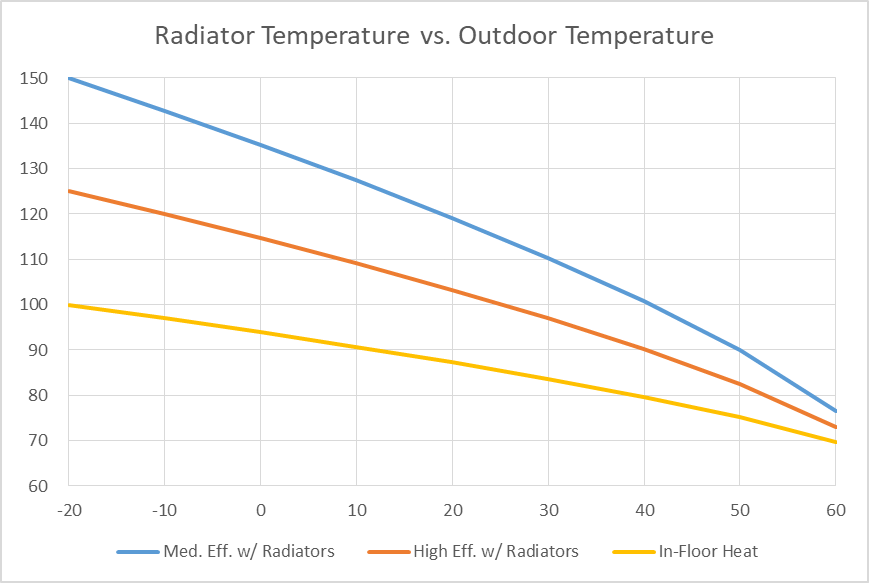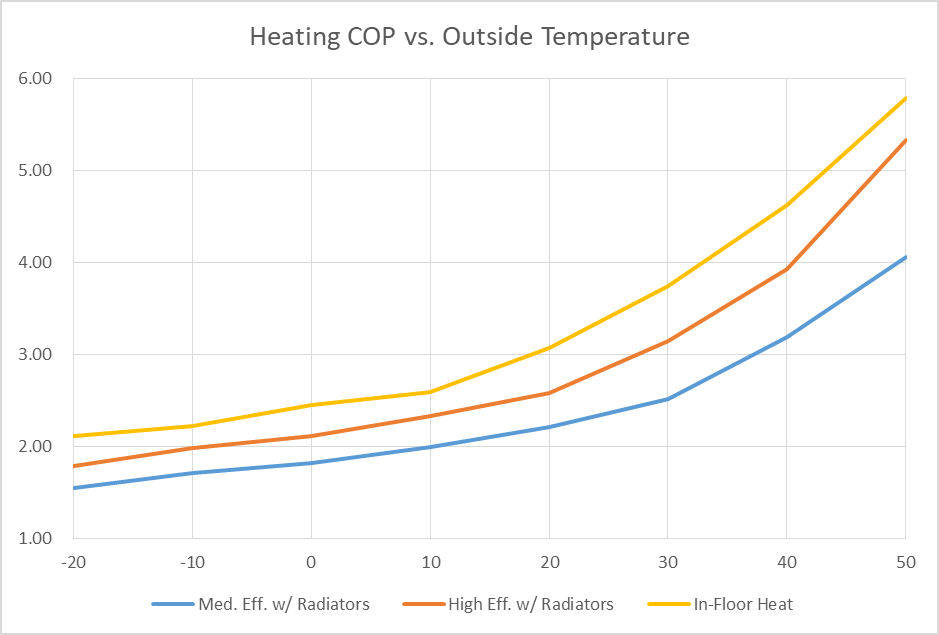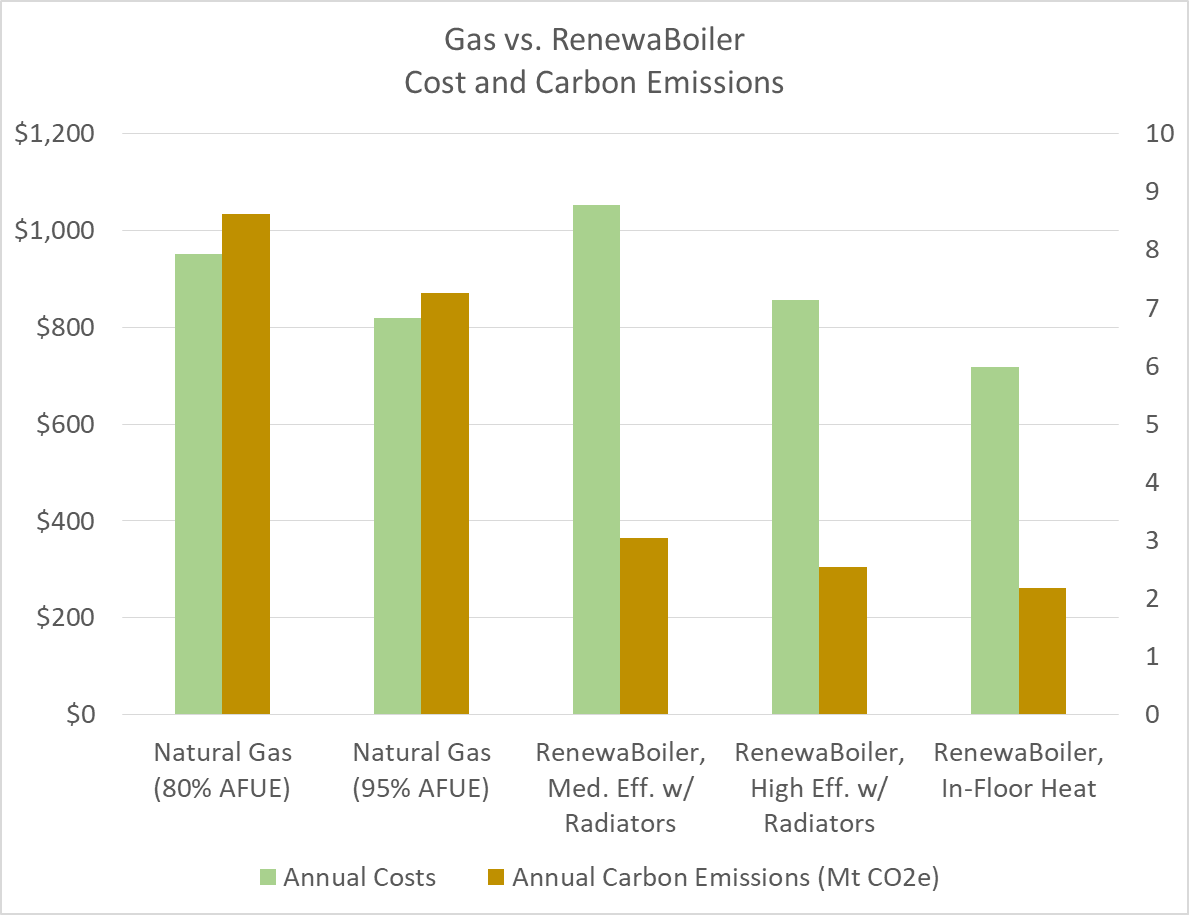RenewaBoiler Energy Efficiency
It's too early to make real measurements for RenewaBoiler, but design projections suggest it can beat natural gas.
For RenewaBoiler to succeed, it will have to compete head-to-head against natural gas. The biggest advantage for gas is its extremely low cost compared to electricity. So, a major key for RenewaBoiler is to use as little energy as possible.
Since RenewaBoiler is still in the design phase, so I can’t exactly run energy measurement tests on it. But I can make some pretty solid efficiency projections based on the system design and the published ratings of the components.
And the results look very promising…
How Energy-Efficient is RenewaBoiler?
Unfortunately, when it comes to heat pump efficiency, there’s never a one-size-fits-all answer. It depends mainly on the “lift” required – which in this case is the temperature difference between the cold outside air and the hot radiant system water. This varies widely based on the climate and the characteristics of the system.
The purpose of a boiler is to keep the radiant system water at the right temperature so the radiators emit exactly as much heat as the home loses to the outside. Systems are designed to maintain this balance when they are running full-blast on the coldest day of the year. For instance, typical design specs for a 1940s-era home in the Twin Cities might be something like:
- -20°F outside temperature
- 100,000 BTU/hr of heat loss
- 180°F radiant system temperature
180°F is way too hot for any heat pump, even RenewaBoiler. But the good news is that nearly every radiator heating system in the Twin Cities was designed for pre-war insulation standards. With even a token amount of modern attic insulation, these homes will lose far less heat than the original design predicted, which means the radiators can run at a much lower temperature.
Most homes in Minneapolis and St. Paul will be just fine with 150°F system temperature on the coldest day of the year. And homes with significant efficiency upgrades can go quite a bit lower.
In-Floor Heating
Nowadays, more homes are being built and retrofitted with radiant floors, ceilings, or walls. Because these radiant surfaces have such a large surface area, they work at a much cooler temperature than cast-iron and baseboard radiators. Design temperature is generally 100°F or even lower.
Three Performance Scenarios
To give an overall picture of RenewaBoiler efficiency, we’ll look at 3 different scenarios:
- A medium-efficiency home with radiators, requiring 150°F water (at the design condition of -20°F).
- A high-efficiency home with radiators, requiring 125°F water.
- A modern home with in-floor heating, requiring 100° water.
We can project RenewaBoiler performance for these homes across a range of outside temperatures, and use historical weather data to determine a weighted average for the Minneapolis/St. Paul area.
First we need to calculate the required radiant system temperature across the outside temperature range. The systems run at their maximum temp at -20°F, and can use cooler water when it’s warmer outside:

Radiant heat system temperatures.
Next we can use the design model to project RenewaBoiler’s efficiency at achieving these radiant system temperatures at the corresponding outside temperature. This efficiency is in terms of COP – Coefficient of Performance – which measures the heat energy output relative to the electrical energy input. (Traditional electric resistance heat from plug-in space heaters or baseboard heaters have a COP of 1.)

RenewaBoiler Projected Efficiency (COP).
You can see that the lower-temperature systems are more energy efficient, and all of the systems are more efficient when it’s warmer outside. But even at the extreme condition of -20°F, they are much better than electric resistance heat.
Finally we can combine these temperature-specific projections with historical average Twin Cities temperatures to estimate a “Seaonal COP” averaged across the heating season:
| Scenario | Seasonal COP |
| Medium-Efficiency Home w/ Radiators (150°F water) | 2.5 |
| High-Efficiency Home w/ Radiators (125°F water) | 3.0 |
| Radiant In-Floor Heat (100°F water) | 3.5 |
It’s important to note that these projections are specific to the Twin Cities. If you live somewhere warmer, the efficiency would be higher. (And if you live somewhere colder, the efficiency would be lower.)
Relating COP to Gas Cost and Emissions
The COP figure isn’t very useful in itself. How does the operating cost compare to gas heating?
The answer depends greatly on your local electric utility. Xcel Energy in Minnesota has an outstanding program for electric heat, so RenewaBoiler is very cost-competitive with gas – a little bit cheaper for the high-efficiency home, and a little bit more expensive for the standard.
(And either way, RenewaBoiler will create far less pollution and eliminate a major safety hazard from your home.)

RenewaBoiler Projected Cost & Emissions.
The chart above shows projected annual costs and carbon emissions for a high-efficiency and standard-efficiency gas boiler along with the three RenewaBoiler scenarios. (The cost projections include savings from eliminating the gas meter fee as well as the Xcel Energy whole-home electricity discount for electric heat customers. Carbon emissions are calculated as shown here and here. )
It’s important to note that all of these figures are just design projections at this point. Before RenewaBoiler is available to install, we will be conducting industry-standard testing to ensure fairness and accuracy. And we will also be publishing real-world case studies of homeowners that make the switch.
But these projections are very encouraging, and show that RenewaBoiler has a real chance to make an impact in the market.
If you’re interested in learning more about RenewaBoiler, I’d love to hear from you! The three best ways to get involved are:
- Email me directly at [email protected]. I read and respond to every email!
- Subscribe to my email list below to stay informed about RenewaBoiler.
- Add a comment or question below.
P.S. The eventual forced-air version of RenewaBoiler will be even more energy-efficient than any of the radiant-heat scenarios…
Next: 100 Million Tons per Year.
About 2040 Energy
We are building RenewaBoiler — the first cold-climate heat pump designed for hot water radiators.
To follow our progress, sign up for email updates below. (We promise to respect your inbox!)